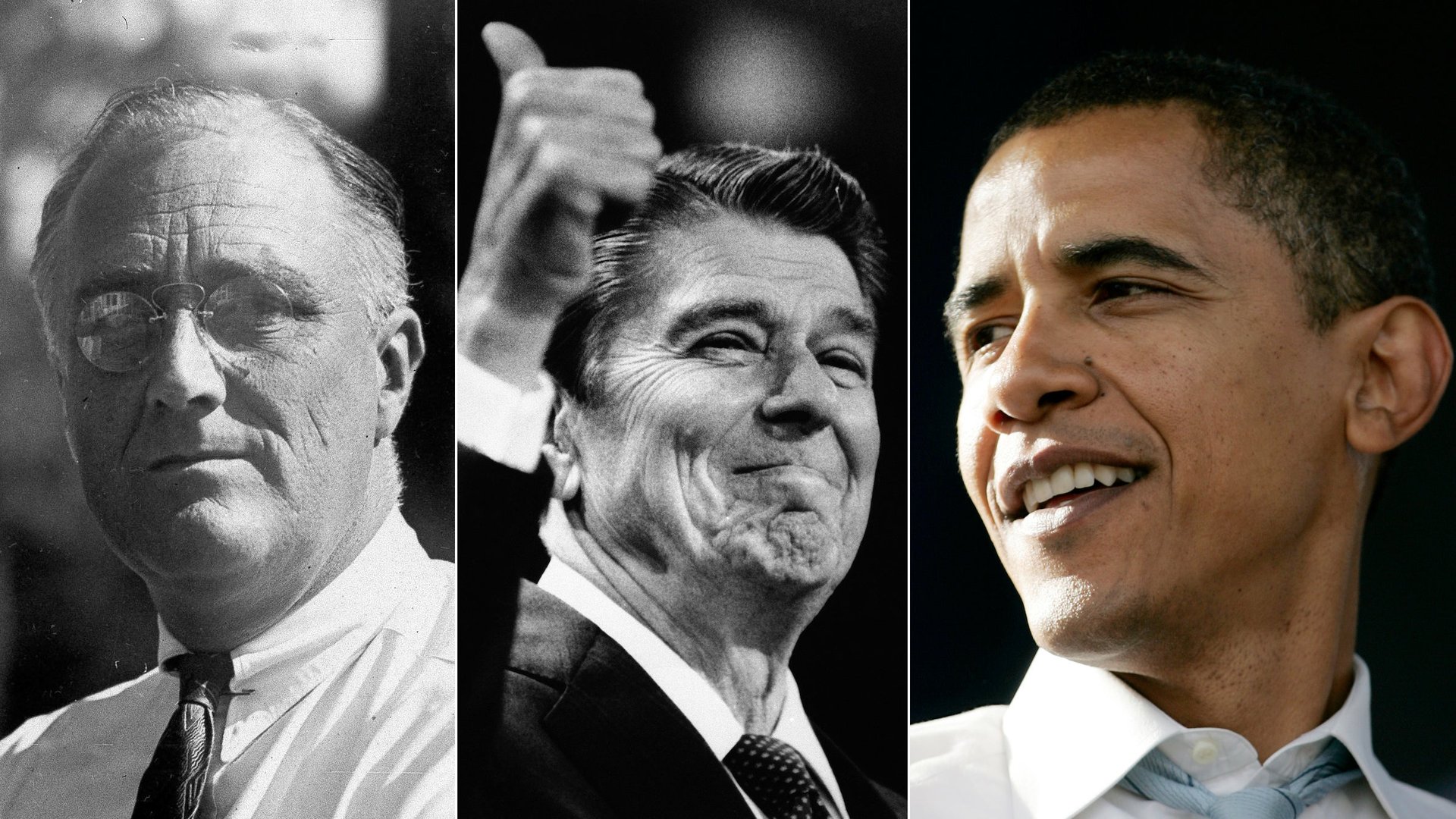Obama has a chance to join Roosevelt and Reagan as an economic icon
Franklin D. Roosevelt pulled the US out of the Depression.


Franklin D. Roosevelt pulled the US out of the Depression.
Ronald Reagan recharged America.
Now Barack Obama has the chance to finish his own sentence.
With his re-election yesterday, President Barack Obama ensured that he’ll be around to receive the credit—or blame—as the policies he put in place in the aftermath of the Great Recession take root. If he presides over an economic resurgence, it will add a new chapter to the debate about the interaction of government and economic growth that has long gripped America and, more recently, Europe and the big emerging markets too.
For 80 years, Roosevelt and Reagan were the only two American presidents in that story who truly mattered. When FDR was elected in 1932, the US economy was in cardiac arrest. In the fifteen months before July 1932, industrial production collapsed by 43%. Unemployment topped 24%. The banking system was imploding, with 9,000 banks closing between 1930 and 1933. Hard-earned savings disappeared overnight for millions of Americans.
With twin gifts for communication and policy improvisation, Roosevelt turned things around, but not overnight. Between, 1933 and 1937, real gross national product increased at a rate of nearly 10% per year, albeit off of scarily low levels. Unemployment was falling slowly, but it remained remarkably high.
The economy returned to recession again in 1938, thanks to a premature turn to austerity. But growth reaccelerated up until the outbreak of World War II. By 1941 unemployment was down to 9.9%. Still incredibly high by current standards, but after the depths of the Depression, seen as manageable.
The FDR-era—four terms! Twelve years!—dominated economic policy-making for decades, with few Republicans openly challenging the cornerstones of his project, such as Social Security.
The pendulum began to swing in the other direction when Ronald Reagan won the White House in 1980, after campaigning on a platform of cutting taxes and shrinking government. It wasn’t the Depression. But times weren’t great. Unemployment was stuck above 7%. Inflation hovered around 12%. To combat rising prices, then-Federal Reserve Chairman Paul Volcker had raised interest rates to unprecedented heights, bringing on a recession in 1981-82. That downturn pushed unemployment up even more, to nearly 11%.
By the end of Reagan’s first term, unemployment was still above 7%. But GDP growth was surging and the jobs engine was starting to roar. Even so, it took until January 1986 for the unemployment rate to punch below 7%. Reagan’s win in 1984 enabled him to hang around to see a massive economic expansion that ended up creating 16 million jobs.
The success of the Reagan era radically reshaped how Americans thought about the economy. In the public mind, the Reagan-era values of low taxes and small government had been proven to foster growth. Never mind that federal government employment grew during his administration and Reagan signed bills that included tax increases, rechristened as “revenue enhancements.” The positive aura of the Reagan era has only gotten stronger in recent years.
Obama’s arrival at the White House came amid near-Rooseveltian levels of crisis. During the first three months of 2009, the economy lost an average of 780,000 jobs a month. The S&P 500 stock index tumbled by 25%. The banking system was a shambles and financial markets were frozen.
There are signs that President Obama’s second term might be characterized by more economic pep than his first. The housing market—long the engine of American economic recoveries—has finally turned. The job market looks as if it is picking up strength. At banks, there is sign of demand for money. All to the good.
But even if a serious economic expansion materializes—and with the fiscal cliff looming and pro-austerity advocates marshaling their forces, it’s far from assured—Obama will need more than good statistics to reshape the economic debate.
That’s because Roosevelt and Reagan did more than preside over a period of economic growth. They defined it, in blunt terms, by laying out their economic philosophy. That doesn’t mean they always adhered to it as they governed. But people understood what they stood for. And when the economy did well, both Roosevelt and Reagan received the credit.
Reagan defined his legacy by saying, “Government is not the solution to our problem. Government is the problem.” Roosevelt, defending his New Deal in 1936, railed against against the financial interests aligned against him saying, “They are unanimous in their hate for me and I welcome their hatred.”
To truly own the recovery, President Obama will have to equally blunt about what he stands for. Such bluntness does not sit easily with the nuanced, carefully-spoken president we have seen so far. But perhaps in his second term, he will be able to take a bolder stance.